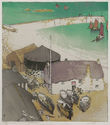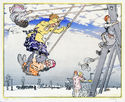
19th, 20th & 21st Century Fine Prints
707-546-7352 · fax 707-546-7924 · web: www.annexgalleries.com · email: artannex@aol.com
John Edgar Platt Biography
John Edgar Platt
British
1886–1967
Biography
John Edgar Platt was born on 19 March 1886 in Leek, Staffordshire, England. He was educated at the High School, Newcastle Under Lyme and at Margate Art School and the Leek School of Art before going to study at the Royal College of Art from 1905 to 1908. After graduating he worked as the head of Leek School of Art for nine years until 1919. Platt quickly developed his skills in oil painting, watercolours, woodcuts and engraved woodblocks and held his first exhibition at the Royal Academy in 1913. Between 1913 and 1916 he worked on the interior design of All Saints Church in Leek, producing stained glass, tapestry designs and murals. In 1917. Platt exhibited at the International Society of Sculptors and at the Arts and Craft Society. Two of his best known prints, Snow in Springtime (1919) and The Giant Stride (1918) are from this period.
After the World War I, Platt exhibited at the New English Art Club and, in 1922, won a gold medal at the International Print Makers' Exhibition. He taught at the Harrogate School of Art throughout 1919, the Derby School of Art in 1920, and was Head of the Department of Fine Art at Edinburgh College of Art between 1920 and 1923, before becoming Principal of the Leicester School of Art from 1923 until 1929, when he moved to London to become head of Blackheath School of Art. Throughout the 1930s Platt produced a number of highly regarded woodcuts and paintings. He published his book Colour Woodcuts: a Book of Reproductions and a Handbook of Method in 1938. From 1938 to 1953, Platt was the President of the Society of Graver Painters in Colour.
During World War II, a number of paintings by Platt were purchased by the War Artists' Advisory Committe and, in 1943, he was awarded a full-time contract to produce paintings for the Ministry of War Transport. Over the next year he painted scenes of river traffic, the maritime rescue services, ocean transport, docks and marshalling yards. He mostly worked on and around the Thames in London from a studio in Putney, but he also visited Liverpool and Cornwall to complete his commission. Platt’s work is in the collections of the British Museum, the Imperial War Museum, the Victoria and Albert Museum, London; the Museum of Fine Arts Boston; the Metropolitan Museum of Art, New York; the Minneapolis Institute of Art, and the Fine Arts Museums of San Francisco.
John Edgar Platt died on April 29, 1967 in Eastbourne, England.





